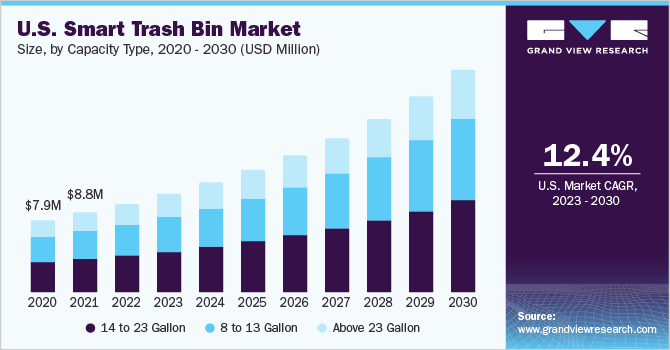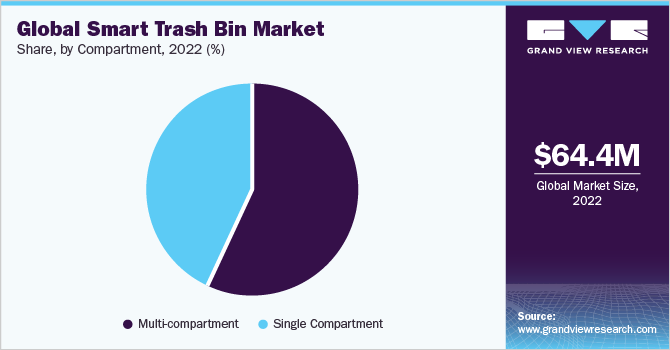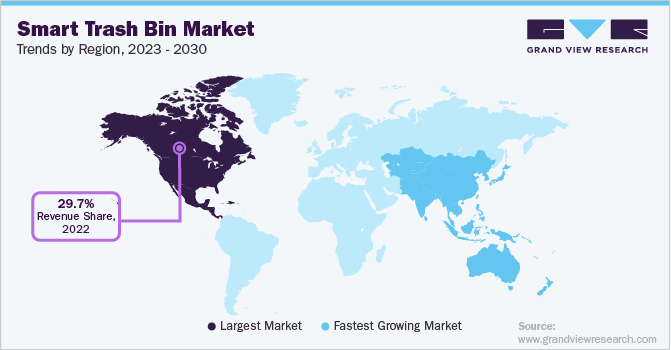- Home
- »
- Next Generation Technologies
- »
-
Smart Trash Bin Market Size, Share & Growth Report, 2030GVR Report cover
![Smart Trash Bin Market Size, Share & Trends Report]()
Smart Trash Bin Market Size, Share & Trends Analysis Report By Capacity Type, By Sales Channel (Online, Offline), By End-user (Residential, Commercial), By Operation, By Compartment, By Region, And Segment Forecasts, 2023 - 2030
- Report ID: GVR-4-68040-045-2
- Number of Report Pages: 120
- Format: PDF, Horizon Databook
- Historical Range: 2017 - 2021
- Forecast Period: 2023 - 2030
- Industry: Technology
Report Overview
The global smart trash bin market size was valued at USD 64.36 million in 2022, expanding at a compound annual growth rate (CAGR) of 12.4% from 2023 to 2030. The industry is growing widely due to the increasing implementation for smart city programs across the globe. The growth of smart cities worldwide has created a need for innovative waste management solutions. Smart trash bins are equipped with sensors, cameras, and other technologies to detect when they are full, compact the trash, and notify waste management companies when they need to be emptied.

Furthermore, the growing need for effective waste management across the globe is another major factor fueling the market growth. The increasing amount of garbage generated worldwide has put pressure on waste management systems. In order to cater to such problems, the local government bodies across the countries have conducted various novel programs. For instance, in November 2021,the Environmental Protection Agency (EPA) announced its biggest investment for waste management in the U.S., of around USD 375 million which was targeted at recycling and waste reduction projects. The funding would launch several new projects at the state and municipal levels to combat pollution and inappropriate waste management, including the Solid Waste Infrastructure for Recycling, Recycling Education and Outreach Grant Programs.
Additionally, the market is expected to be driven by the rising proliferation of Internet of Things (IoT) and Artificial Intelligence (AI) technologies.Smart trash bins are equipped with sensors, cameras, and other technologies that can detect when they are full and automatically compact the garbage. These technologies are enabled by the integration of IoT and AI, making smart trash bins more efficient and effective than traditional waste management systems. Moreover, smart trash bins generate real-time data on waste generation, collection, and disposal. This data can be analyzed using AI algorithms to identify patterns and optimize waste management systems further.
The smart trash bin market has significant potential for growth and innovation as cities and businesses increasingly prioritize sustainability and environmental responsibility. By leveraging IoT, AI, and other technologies, smart trash bins can help transform waste management practices and promote a more sustainable future. However, the high cost of the product and the lack of awareness among consumers about the benefits of these bins are some of the factors that may restrain the growth of the market.
COVID-19 Impact
The COVID-19 pandemic has had a significant impact on the global economy, with many industries and markets being affected. Also, the pandemic is a cause to several changes and disruptions in this industry. One of the most significant impacts of the pandemic witnessed is the increased demand for contactless garbage disposal solutions. With the emphasis on reducing contact with potentially contaminated surfaces, the demand for smart trash bins equipped with sensors and automated opening and closing mechanisms has increased. These contactless solutions allow touch-free garbage disposal and reduces the risk of cross-contamination.
However, the pandemic has also caused disruptions in global supply chains, resulting in delayed production and shipment of smart trash bins. This has led to a shortage of some models, and increased prices due to limited availability. Additionally, the pandemic has caused some manufacturers to shift their focus to producing essential medical supplies and equipment, which has further reduced the supply of smart trash bins. On the other hand, the pandemic has reduced the adoption of smart trash bins in some sectors, such as commercial offices and public spaces owing to the work from home policies.
Capacity Type Insights
In terms of capacity type, the market is classified into 8 to 13 gallon, 14 to 23 gallon, and above 23 gallon. The 14 to 23 gallon segment dominated the overall market, gaining a market share of 41.31% in 2022. This dominance can be attributed to the wide availability of a large variety of goods in capacities ranging from 13.2 gallons to 14 gallons, 15 gallons, 18 gallons, and 22 gallons among others. Furthermore, 14 to 23 gallons are very popular in the business sector, as they require trash cans with greater capacity to collect enormous volumes of scrap created by hotels, public bathrooms, and hospitals, among other places.
The 8 to 13 gallon segment is expected to emerge as the fastest CAGR of 12.8% over the forecast period. Smart trash cans with sizes ranging from 8 to 13 gallons are extensively used in the home, notably in kitchens, rooms, and other areas. These are also widely found in business settings such as workplaces, cabins, hotel rooms, and hospital rooms. With increasing awareness about the smart trash cans and probable reduction in the prices is expected to contribute to the increase in demand for 8 to 13 gallon capacity segment.
Sales Channel Insights
In terms of sales channel, the market is classified into online and offline channel. The offline segment dominated the over market in 2022 with a market share of about 48.43%. An offline physical store enables retailers to reach out to customers and offer them instant experience as the client does not have to wait long to receive the product. Furthermore, the merchant provides the consumer with the easy option of returning items, as well as personal support in the decision-making process or with installation and maintenance.
The online segment is expected to emerge as the fastest growing segment in the forecast period. Internet is a terrific medium to market any product, including smart trash bins which are heavily marketed on online platforms by the market players. Additionally, online platforms allow more alternatives for customers to look at and pick the desired product, and hence demand for smart trash bins is expected to rise. Retail stores including Amazon and eBay, as well as omni-channel stores such as Walmart and Costco, carry a wide range of brands and offer speedier product delivery.
End-user Insights
In terms of End-user, the smart trash bin market is classified into residential and commercial segment. Among these, the commercial segment dominated the market in 2022 and accounted for a market share of 61.34%. The growth of commercial segment can be attributed to the increasing popularity of smart cabinets in commercial sectors due to their ability to streamline waste management processes, reduce costs, and improve sustainability efforts. Smart trash bins utilize various technologies such as sensors, data analytics, and IoT to provide a more efficient and effective approach to waste management.
The residential segment is anticipated to register the fastest CAGR over the forecast period. One of the main advantages of smart trash bins in residential areas is their ability to automate waste management processes. These bins can be equipped with sensors that detect when they are full or when specific types of waste are present, allowing for more efficient and effective sorting and disposal. This can help to reduce the amount of time and effort required for residents to manage their scrap, making it a more convenient and hassle-free process.
Operation Insights
In terms of operation, the smart trash bin market is classified into automatic and semi-automatic segment. Among these, the automatic segment dominated the market in 2022 and accounted for a market share of 55.03% and is anticipated to retain its dominance over the projected period. An automatic smart trash bin helps to reduce the amount of waste that goes to landfills, simplify waste management, and improve hygiene by reducing the need to touch the bin when disposing of waste. Furthermore, a smart trash bin is designed to simplify the process of managing waste by automatically detecting and sorting waste and recycling materials.
The semi-automatic segment held a considerable market share in the year 2022. One of the main advantages of smart trash bins in residential areas is their ability to automate waste management processes. Semi-automatic bins are waste disposal systems that require manual intervention to operate/open the trash bin. Moreover, semi-automatic bins provide a convenient and hygienic way to dispose of waste, while still allowing for some manual control. They can be suitable for use in homes, offices, or public spaces where a fully automatic bin may not be necessary.
Compartment Insights
In terms of compartment, the smart trash bin market is classified into single and multi-compartment. Among these, the multi-compartment segment dominated the market in 2022 and accounted for a market share of 59.95% and is projected to retain its dominance in the forecast period. Multi-compartment bins are waste disposal systems that are designed with separate compartments to collect different types of waste. These bins typically have sensors that detect the type of waste disposed and further sort it into the appropriate compartment.

The semi-automatic segment held a considerable market share in the year 2022. Single compartment bins are waste disposal systems that have a single compartment for all types of waste. These bins typically have sensors that detect when garbage is added to the bin and can automatically initiate the compaction process to reduce the amount of space used. The single compartment bins are generally used for disposal of dedicated wastes such as paper, cardboards, waste cloth, etc. in offices, hotels, and commercial places.
Regional Insights
North America led the overall market in 2022, with a market share of 29.70%. The regional growth can be attributed to presence of prominent smart waste bin manufacturers and sellers in North America including Nine Stars Group (USA) Inc., iTouchless Housewares & Products, Inc., and Simplehuman. These players are focusing on strategic growth through mergers and acquisitions as well as new product releases. Furthermore, the region, particularly the United States, is seeing a boom of smart trash bins, owing to the strong desire to adopt cutting-edge technology. At the same time, the region's high buying power and increased investments by industry participants in cutting-edge technologies are driving the regional expansion.

The Europe is anticipated to exhibit a considerable CAGR of 12.5% throughout the forecast period. Smart garbage bins are becoming increasingly popular in Europe due to the region’s focus on sustainability and garbage reduction. Many European countries such as France, Germany, and U.K. among others have implemented strict waste management regulations and are committed to reducing garbage sent to landfills. For instance, The Waste Management Act (Kreislaufwirtschaftsgesetz) is the main legal framework for waste management in Germany. It outlines the principles of waste management, including waste prevention, recycling, and recovery.
Key Companies & Market Share Insights
The market is fairly fragmented and is expected to witness increased competition in coming years due to presence of several players and market entry of new players. Major players are spending heavily on research and development activities to integrate advanced technologies in smart trash bin. The key players in the target market include Ausko Pte Ltd., iTouchless Housewares & Products, Inc., EcubeLabs, Simplehuman, and HANGSHAU Houseware Co., Ltd, among others. These players are pursuing several strategic initiatives, such as mergers & acquisitions and new product launches, in order to strengthen their foothold in the market, expand their market share, and improve their profitability. For instance, in March 2021, Enevo Group was acquired by REEN, a technology business. The purchase will boost REEN's position in technical solutions to modernize and simplify waste management. Some prominent players in the global smart trash bin market include:
-
Ausko Pte Ltd.
-
iTouchless Housewares & Products Inc.
-
EcubeLabs
-
Simplehuman
-
HANGSHAU Houseware Co. Ltd.
-
EKO USA
-
Home Depot Inc.
-
EvoEco
-
CleanRobotics
-
Nine Stars Group Inc
-
Binology LLC
-
Honey Can Do International
-
BIG BELLY LLC.
Smart Trash Bin Market Report Scope
Report Attribute
Details
Market size value in 2023
USD 71.50 million
Revenue forecast in 2030
USD 162.02 million
Growth Rate
CAGR of 12.4% from 2023 to 2030
Historic year
2017 - 2021
Base year for estimation
2022
Forecast period
2023 - 2030
Quantitative units
Revenue in USD Million/Billion and CAGR from 2023 to 2030
Report coverage
Revenue forecast, company ranking, competitive landscape, growth factors, and trends
Segments covered
Capacity, sales channel, End-user, operation, compartment, region
Regional scope
North America; Europe; Asia Pacific; South America; Middle East & Africa
Country scope
U.S.; Canada; Mexico; Germany; U.K.; France; China; India; Japan; Brazil
Key companies profiled
Ausko Pte Ltd.; iTouchless Housewares & Products; Inc.; EcubeLabs; Simplehuman; HANGSHAU Houseware Co.; Ltd.; EKO USA; Home Depot; Inc.; EvoEco; CleanRobotics; Nine Stars Group Inc; Binology LLC; Honey Can Do International; BIG BELLY LLC.
Customization scope
Free report customization (equivalent up to 8 analysts working days) with purchase. Addition or alteration to country, regional & segment scope.
Pricing and purchase options
Avail customized purchase options to meet your exact research needs. Explore purchase options
Global Smart Trash Bin Market Report Segmentation
This report forecasts market revenue growths at global, regional, as well as at country levels and offers an analysis of the qualitative and quantitative market trends in each of the sub-segments from 2017 to 2030. For this study, Grand View Research has segmented the global smart trash bin market report based on capacity, sales channel, end-user, operation, compartment, and region.
-
Capacity Outlook (Revenue, USD Million; 2017 - 2030)
-
8 to 13 gallon
-
14 to 23 gallon
-
above 23 gallon
-
-
Sales Channel Outlook (Revenue, USD Million; 2017 - 2030)
-
Online
-
Offline
-
-
End-user Outlook (Revenue, USD Million; 2017 - 2030)
-
Residential
-
Commercial
-
-
Operation Outlook (Revenue, USD Million; 2017 - 2030)
-
Automatic
-
Semi-Automatic
-
-
Compartment Outlook (Revenue, USD Million; 2017 - 2030)
-
Single Compartment
-
Multi-compartment
-
-
Regional Outlook (Revenue, USD Million; 2017 - 2030)
-
North America
-
U.S.
-
Canada
-
Mexico
-
-
Europe
-
Germany
-
U.K.
-
France
-
-
Asia Pacific
-
China
-
India
-
Japan
-
-
South America
-
Brazil
-
-
Middle East & Africa
-
Frequently Asked Questions About This Report
b. The global smart trash bin market size was estimated at USD 64.36 million in 2022 and is expected to reach USD 71.50 million in 2023.
b. The global smart trash bin market is expected to grow at a compound annual growth rate of 12.4% from 2023 to 2030 to reach USD 162.02 million by 2030.
b. The North America region accounted for maximum revenue share in 2022. The market dominance can be attributed to presence of prominent smart waste bin manufacturers in the region.
b. Some of the key players in the global smart trash bin market include Ausko Pte Ltd., iTouchless Housewares & Products, Inc., EcubeLabs, Simplehuman, and HANGSHAU Houseware Co., Ltd.
b. The increasing implementation of smart city programs across the globe, effective waste management with smart trash bins, and improved hygiene with touchless automatic bins are expected to significantly contribute to the smart trash bin market growth.
Share this report with your colleague or friend.
![gvr icn]()
NEED A CUSTOM REPORT?
We can customize every report - free of charge - including purchasing stand-alone sections or country-level reports, as well as offer affordable discounts for start-ups & universities. Contact us now
![Certified Icon]()
We are GDPR and CCPA compliant! Your transaction & personal information is safe and secure. For more details, please read our privacy policy.
We are committed towards customer satisfaction, and quality service.
"The quality of research they have done for us has been excellent."





